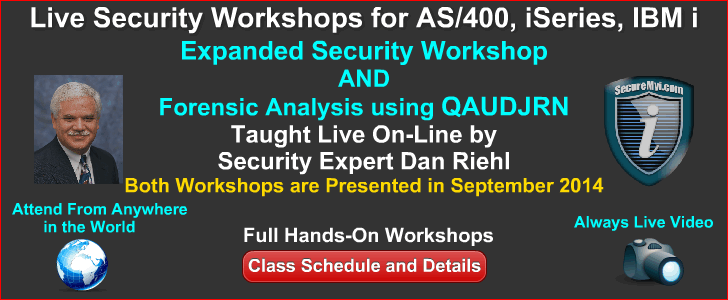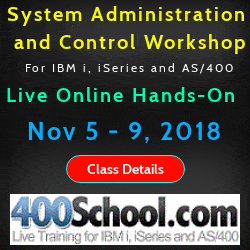
|
||
|
SecureMyi.com Security and Systems Management Newsletter for the IBM i
July 23, 2014 - Vol 4, Issue 12
|
||

|
||



|
Feature Article
|
|
In This Issue
Quick Links
Our Newsletter Sponsors
Platinum Sponsor |
IBM i Security ResourcesIBM i Security Videos - SecureMyi RedBook - Security Guide IBM i Open Security Foundation - DataLoss DB National Vulnerability Database - NIST 


|


|

|



|
Security Shorts - Object Auditing in QSYS and in the IFSBy Dan Riehl - SecureMyi.com The IBM i has excellent built-in auditing capabilities. You can audit various types of important events, you can audit object access, and you can audit access to IFS "objects". I have used the object auditing facilities quite heavily for QSYS objects, and have written about object auditing often in the newsletter. But, the other day I was stumped. I was asked the question "How do you turn on auditing for newly created files and directories in the IFS?" I knew that there was a way to do this, but the method did not come readily to mind. After searching the web for and performing quite a bit of testing, I now have the answer to that question. I hope that the information is helpful to you. Perhaps you had the same question. Auditing newly Created QSYS.LIB ObjectsThe System value QCRTOBJAUD specifies the global default value for the auditing level specified for newly created objects. The shipped value is *NONE, meaning, newly created objects will not be audited at the global/system level. You can override the QCRTOBJAUD system value at the library level by specifying the CRTOBJAUD parameter of the CRTLIB and CHGLIB command as shown here. CHGLIB LIB(MYLIB) CRTOBJAUD(*CHANGE) When a library is created, the default value for the CRTLIB's CRTOBJAUD parameter is *SYSVAL, but can be set as desired to *ALL, *CHANGE, *USRPRF, *NONE or *SYSVAL. CRTLIB LIB(MYLIB) - - CRTOBJAUD(*CHANGE) So, now, whenever a new object is created in MYLIB, the object's OBJAUD value will automatically be set to *CHANGE. Auditing newly Created IFS "Objects"The IFS /root file system is used to store various types of files, directories, folders and documents. Often sensitive data is stored there; MS/Excel spreadsheets, document images, pdf files, and PC application objects to name a few types. In addition to being the global setting for the QSYS file system, the system value QCRTOBJAUD is also the global setting applied to IFS directories. If you want to turn on auditing for all newly created IFS "objects", you set the system value QCRTOBJAUD as required to *ALL, *CHANGE or *USRPRF. Within the IFS, this global setting can be overridden at the directory level using the CHGATR command as shown here. CHGATR OBJ('home/myuser') ATR(*CRTOBJAUD) VALUE(*CHANGE) If you want the *CRTOBJAUD auditing attribute to be applied to subdirectories also, include the SUBTREE(*ALL) option of the CHGATR command. So, the key to managing auditing for newly created objects in the IFS is the CHGATR command. You specify the *CRTOBJAUD attribute and corresponding value for the directory, and optionally for the associated sub-directories. |
Sponsored Links
IBM i, iSeries and AS/400
|
|

|
||

|
||
|
Send your IBM i Security and Systems Management News and Events! Send your Questions, Comments, Tips and Stories Copyright 2014 - SecureMyi.com, all rights reserved SecureMyi.com | St Louis MO 63017 |
||
